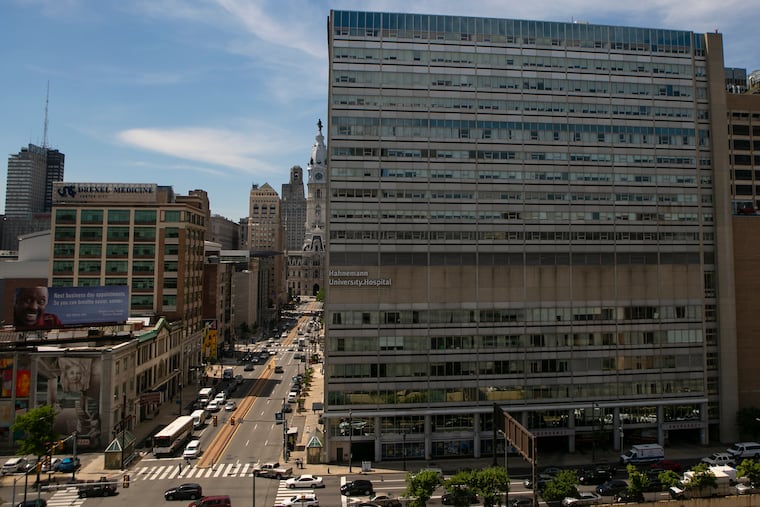As Hahnemann enters bankruptcy, ‘gateway’ development site could open up in Center City
The Hahnemann property’s size and central location give its potential redevelopment a much higher profile than past conversions of hospital sites.

When the dust settles on the bankruptcy of Hahnemann University Hospital, what’s left behind may be one of the most enticing — if challenging — pieces of real estate that Philadelphia has seen in years.
The sprawling assemblage of seven medical buildings and a parking garage over nearly six acres is centered on Broad Street along the Vine Street Expressway, cater-cornered to the growing Pennsylvania Convention Center, and at the northern end of the strip of cultural institutions that make up what’s known as Avenue of the Arts.
While employing thousands and providing vital medical services for some of central Philadelphia’s neediest neighborhoods, the buildings are quickly growing obsolete for hospital use and have dampened street life between Center City and revitalizing sections of Broad Street to the north, some say.
“It’s kind of a gateway location,” said Joseph Fetterman, an executive vice president at real estate services group Colliers International in Philadelphia specializing in health-care properties. “It’s a real opportunity to put another piece in place that continues the redevelopment of North Broad Street.”
If the Hahnemann campus is redeveloped, it would join a growing number of financially troubled hospitals to be shuttered in Philadelphia, only to reopen with a new identity.
Some retain at least some medical use. The former Northeastern Hospital in Port Richmond, for example, is now partly occupied by an urgent-care facility.
But others are being revamped into something completely different. Among these is the old St. Joseph’s Hospital at 16th Street and Girard Avenue, which is now an apartment building.
Still, the Hahnemann property’s size and central location give its potential redevelopment a much higher profile than past cases, developers and experts said.
“It requires big thinking, big bold ideas, and extremely deep pockets,” said Bill Luff, founder of real estate consultant CRE Visions LLC in Philadelphia.
Since moving into what’s now known as the campus’ South Tower at 230 N. Broad St. in 1928, Hahnemann has grown to encompass 1.5 million square feet of hospital space, according to an Inquirer tally of city property records.
While much of that space is in the dense cluster of buildings attached to the South Tower, some functions are in properties on surrounding blocks held by affiliates of the hospital’s owner, California-based investment banker Joel Freedman’s Philadelphia Academic Health System LLC.
Philadelphia Academic, which filed for bankruptcy protection late Sunday, leases its space in those buildings from those property-owning affiliates, which are not part of the Chapter 7 filing, according to court papers.
The filing came after Philadelphia Academic, which acquired Hahnemann last year, failed in its effort to find a buyer for the money-losing hospital. Among those passing on an acquisition was Drexel University, which uses Hahnemann as the primary teaching hospital for its medical school, according to court filings.
Drexel had considered buying the hospital once before earlier this decade from its previous owner, Tenet Healthcare Corp., but had then, too, decided not to go through with the deal, said Robert Francis, Drexel’s former vice president for university facilities.
Francis said he had toured the hospital buildings in connection with that potential acquisition and had thought even then that it would be a struggle to make the aged building with outdated electrical and mechanical systems able to support today’s high-tech medical devices.
At least one section of the complex isn’t even used anymore: City records show that the property known as the SHSH Building at 15th and Race Streets, part of the main hospital cluster, has been all but vacant since 2008.
“It’s a pretty difficult physical plant to modernize for health care,” Francis said of the hospital complex.
If Hahnemann’s owners realize their plan to shut down the hospital in coming months, it’s far too early to predict what might rise in its place, developers and other experts said.
Its sale price and redevelopment budget would also depend on its ultimate use, and whether existing buildings are repurposed or demolished to make way for new construction, said Luff, of CRE Visions.
Fetterman, with Colliers, said he envisions some downsized version of the property’s current medical use migrating to other buildings in the area, with the Hahnemann land itself being developed for a mix of uses, possibly including a hotel to house visitors to the nearby convention center.
Robert Zuritsky, president of developer Parkway Corp., whose Broad Street headquarters is across Race Street from the main Hahnemann buildings, said he’d like to see something that could restore some of the employment that will be lost when the hospital closes.
One idea, he said, could be technology and research businesses that take advantage of the area’s telecommunications infrastructure, which has already led to the development of big data centers in buildings to the north.
Paul Levy, president of the Center City District business association, said that his group would lament the loss of the hospital, but that a silver lining to its closure would be the opportunity to make its strip of Broad Street more inviting for street life.
“The top priority is to preserve the medical services and jobs the hospital represents,” he said. "If, unfortunately, it was impossible to save them ... it could create a whole new zone in the city.